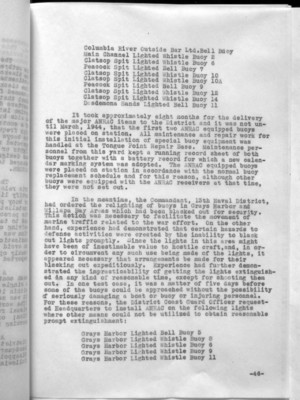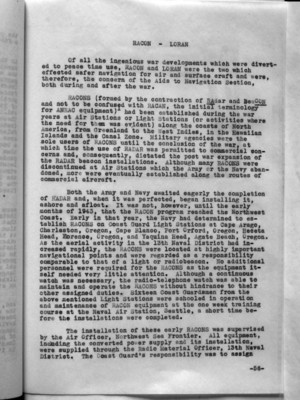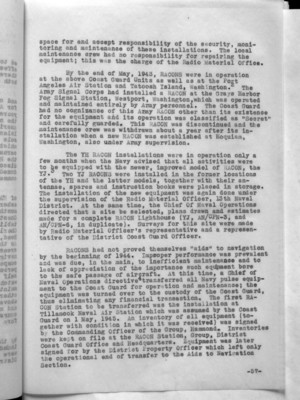Pages That Mention PERSONNEL
Coast Guard District narrative histories 1945
61
be blacked out by the unit having charge of that area. Commanding Officers were instructed to exercise their best judgement in the assignment of trucks, tenders, or small boats and these assignments were determined in advance.
Commanding Officers were further directed to familiarize themselves with the aids in their area, securing keys necessary for entrance to equipment and to properly instruct personnel under their command, in order that the blackout could be carried out smoothly and expeditiously. Sound buoys were silenced by securely lashing bell clappers or air intakes and whistles were wrapped with canvas and securely lashed. The District Coast Guard Office was to be notified by dispatch when the blackout had been effected or aids had been relighted, in accordance with District orders.
In October, 1941, a conference was held at Tongue Point Depot, Astoria, Oregon, to instruct personnel from that area in the operations required of the various types of aids to navigation to effect the Blackout Plan. A blackout drill of all units under command of the Astoria Base was held on October 22, 1941. Each aid was visited and examined by the personnel assigned thereto to ascertain type of equipment, the correct way to make the aid inoperative and the tools and materials required. During the practice, only an examination was made and the operation of the aids was not stopped. This was the only test of its kind in the 13th Naval District prior to the outbreak of the war.
On 9 December, 1941, a blackout was effected in the entire District on instructions from the District Commandant. Three officers, together with a small staff of enlisted personnel, issued instructions to the various Commands from the Aids to Navigation Office. Orders for the blackout were received at 1400 and, by 2200, the blackout was completely effected. Tremendous obstacles were encountered, there having been no previous test of the Plan as set by the Board in September. Bridges throughout the District were blacked out, although no plan had incorporated such procedure and railroad officials as well as highway superintendents offered little cooperation. No word was received from the blacked areas as to the time their aids were extinguished nor was word received that they had been relighted following the blackout. This was due to the inability of telephone and radio facilities to handle such heavy traffic. No report was required concerning the results of the operation and a general blackout, other than tests in various areas, was every made in the District.
-41-
63
The District Liaison Officer suggested a system for the control of coastal lighthouses as employed by the Canadian Navy to be initiated in a similar way for U. S. Lighthouses. The Canadian Plan consisted of a broadcast three times a day at regular hours to all lighthouse keepers along the Coast. The system was divided into lettered plans; i.e., Plan "A" meant to keep lights burning bright, "B", submarine scare and all lights must be extinguished, etc. The District Coast Guard Officer did not accept this recommendation as the District plan then in use provided for extinguishment or relighting of any or all lights on a few minutes advance notice. The District system had the following advantages:
(a) It provided more positive communication and means of checking receipt of instruction.
(b) It provided greater security and more flexibility of instruction.
(c) It did not depend on any outside agency.
Proposals for dimming coastal lights were di(s)approved because of the unlighted gaps between lights which would have existed when the lights were dimmed.
A test blackout was held in March, 1942, for all Lifeboat and Light Stations. As a result of this test, it was decided that Seattle Radio Station, Westport, would, in the future, broadcast a whistle blast preceding the instructions for blackout. Upon hearing the whistle over the air, all personnel standing radio watches were instructed to copy the message which followed and notify their Commanding Officers. Because of the possibility that telephone communications between Lifeboat and Light Stations might not be available at the time a blackout was ordered, all Light Stations which were radio-equipped were ordered to maintain a radio watch during the entire time the light was burning.
Revisions of the Blackout Plan^1 were made periodically to keep each section of the District cognizant of any changes in that particular area. After each revision, holders of Blackout Plans were ordered to destroy copies of previous Plans by burning. In 1945, a complete coverage of state railroad bridges, covering the area as far east as the Cascades, was completed and included in the Plan. It was advised by the Aids to Navigation Officer that similar blackout regulations be continues during peace time so that any confusion, in the event of a similar emergency, might be eliminated. It was further recommended that tests of the Plan be made occasionally be effecting a total blackout as there was no
-43-
66
Columbia River Outside Bar Ltd.Bell Buoy Main Channel Lighted Whistle Buoy 2 Clatsop Spit Lighted Whistle Buoy 6 Peacock Spit Lighted Bell Buoy 7 Clatsop Spit Lighted Whistle Buoy 10 Clatsop Spit Lighted Whistle Buoy 10A Peacock Spit Lighted Bell Buoy 9 Clatsop Spit Lighted Whistle Buoy 12 Clatsop Spit Lighted Whistle Buoy 14 Desdemona Sands Lighted Bell Buoy 11
It took approximately eight months for the delivery of the major ANRAC items to the District and it was not until March, 1944, that the first two ANRAC equipped buoys were placed on station. All maintenance and repair work for this initial installation of special buoy equipment was handled at the Tongue Point Repair Base. Maintenance personnel from this yard kept a running record sheet of both buoys together with a battery record for which a new calendar marking system was adopted. The ANRAC equipped buoys were placed on station in accordance with the normal buoy replacement schedule and for this reason, although other buoys were equipped with the ANRAC receivers at that time, they were not set out.
In the meantime, the Commandant, 13th Naval District, had ordered the relighting of buoys in Grays Harbor and Willapa Bay Areas which had been blacked out for security. This action was necessary to facilitate the movement of marine traffic related to the war effort. On the other hand, experience had demonstrated that certain hazards to defense activities were created by the inability to black out lights promptly. Since the lights in this area might have been of inestimable value to hostile craft, and, in order to circumvent any such use being made of the lights, it appeared necessary that arrangements be made for their blacking out expeditiously. Experience had further demonstrated the impracticability of getting the lights extinguished in any kind of reasonable time, except for shooting them out. In one test case, it was a matter of five days before some of the buoys could be approached without the possibility of seriously damaging a boat or buoy or injuring personnel. For these reasons, the District Coast Guard Officer requested Headquarters to install ANRAC on the following lights where other means could not be utilized to obtain reasonable prompt extinguishment:
Grays Harbor Lighted Bell Buoy 5 Grays Harbor Lighted Whistle Buoy 8 Grays Harbor Lighted Whistle Buoy 6 Grays Harbor Lighted Whistle Buoy 9 Grays Harbor Lighted Whistle Buoy 11
-46-
76
Of all the ingenious war developments which were diverted to peace time use, RACON and LORAN were the two which effected safer navigation for air and surface craft and were, therefore, the concern of the Aids to Navigation Section, both during and after the war.
RACONS (formed by the contraction of RAdar and BeaCON and not to be confused with RACAN, the initial terminology for ANRAC equipment)¹ had been established during the war years at Air Stations or Light Stations (or activities where the need for them was evident) along the coasts of North America, from Greenland to the West Indies, in the Hawaiian Islands and the Canal Zone. Military agencies were the sole users of RACONS until the conclusion of the war, at which time the use of RADAR was permitted to commercial concerns and, consequently, dictated the post war expansion of the RADAR beacon installations. Although many RACONS were discontinued at Air Stations which the Army or the Navy abandoned, more were eventually established along the routes of commercial aircraft.
Both the Army and Navy awaited eagerly the completion of RADAR and, when it was perfected, began installing it, ashore and afloat. It was not, however, until the early months of 1943, that the RACON program reached the Northwest Coast. Early in that year, the Navy had determined to establish RACONS on Coast Guard Light Stations at Cape Arago, Charleston, Oregon, Cape Blanco, Port Orford, Oregon, heceta Head, Florence, Oregon, and Yaquina Head, Agate Beach, Oregon. As the aerial activity in the 13th Naval District had increased rapidly, the RACONS were located at highly important navigational points and were regarded as a responsibility comparable to that of a light or radiobeacon. No additional personnel were required for the RACONS as the equipment itself needed very little attention. Although a continuous watch was necessary, the radio-telephone watch was able to maintain and operated the RACONS without hindrance to their other assigned duties. Sixteen Coast Guardsmen from the above mentioned Light Stations were schooled in operation and maintenance of RACON equipment at the one week training course at the Naval Air Station, Seattle, a short time before the installations were completed.
The installation of these early RACONS was supervised by the Air Officer, Northwest Sea Frontier. All equipment, including the converted power supply and its installation, were supplied through the Radio Material Officer, 13th Naval District. The Coast Guard's responsibility was to assign
-56-
77
space for and accept responsibility of the security, monitoring and maintenance of these installations. The local maintenance crew had no responsibility for repairing the equipment; this was the charge of the Radio Material Office.
By the end of May, 1943, RACONS were in operation at the above Coast Guard Units as well as at the Port Angeles Air Station and Tatoosh Island, Washington. The Army Signal Corps had installed a RACON at the Grays Harbor Fog Signal Station, Westport, Washington, which was operated and maintained entirely by Army personnel. The Coast Guard had no cognizance of this Army RACON other than its existence for the equipment and its operation was classified as "Secret" and carefully guarded. This RACON was discontinued and the maintenance crew was withdrawn about a year after its installation when a new RACON was established at Hoquiam, Washington, also under Army supervision.
The YH RACON installations were in operation only a few months when the Navy advised that all activities were to be equipped with the newer, improved model of RACON, the YJ.³ Two YJ RACONS were installed in the former locations of the YH and the latter models, together with their antennae, spares and instruction books were placed in storage. The installation of the new equipment was again done under the supervision of the Radio Material Officer, 13th Naval District. At the same time, the Chief Of Naval Operations directed that a site be selected, plans drawn and estimates made for a complete RACON Lighthouse (YJ, AN/CPN-3, and AN/CPN-6, in duplicate). Surveys for this site were made by Radio Material Officer's representative and a representative of the District Coast Guard Officer.
RACONS had not proved themselves "aids" to navigation by the beginning of 1944. Improper performance was prevalent and was due, in the main, to inefficient maintenance and to lack of appreciation of the importance such equipment bore to the safe passage of aircraft. At this time, a Chief of Naval Operations directive^4 transferred all Navy pulse equipment to the Coast Guard for operation and maintenance; the equipment was turned over to the custody of the Coast Guard, thus eliminating any financial transaction. The first RACON Station to be transferred was the installation at Tillamook Naval Air Station which was assumed by the Coast Guard on 1 May, 1945. An inventory of all equipment (together with condition in which it was received) was signed by the Commanding Officer of the Group, Hammond. Inventories were kept on file at the RACON Station, Group, District Coast Guard Office and Headquarters. Equipment was later signed for by the District Property Officer which left only the operational end of transfer to the Aids to Navigation Section.
-57-




